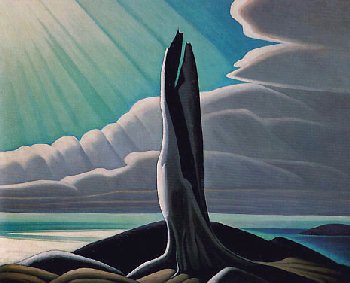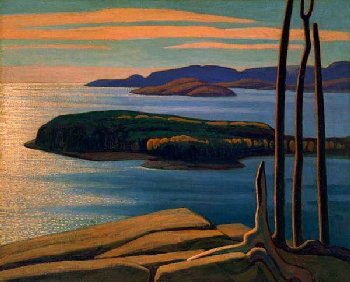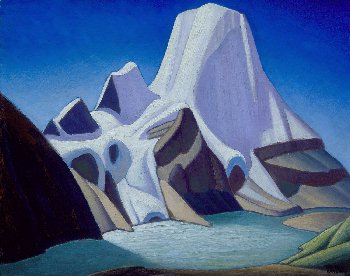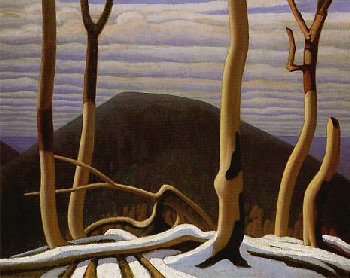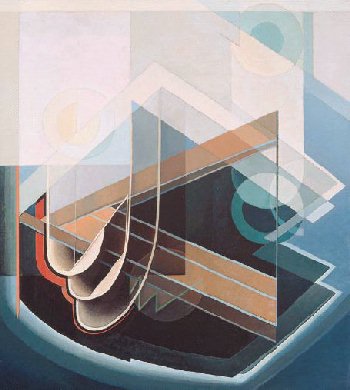| Lawren Harris
The Art History Archive - Canadian Art
The Group of Seven
Lawren Harris Biography: Lawren Stewart Harris (October 23, 1885 – January 29, 1970) was a Canadian painter born in Brantford, Ontario, who was one of the best known landscape painters of the Group of Seven, a group of artists who set out to create a distinctly Canadian art. He pioneered a distinctly Canadian painting style in the early twentieth century. Lawren Harris was born into a wealthy family on October 23rd 1885. He was the first born of two sons. He attended St. Andrew's College in Toronto, and then from age 19 (1904 to 1908) he studied in Berlin. He was interested in philosophy and eastern thought. Later, he became involved in Theosophy and joined the Toronto Lodge of the International Theosophical Society. In his youth Lawren Harris moved to Toronto, Ontario. He first studied art in Berlin, Germany, from 1904 to 1908. He then returned to Toronto, where he began painting post-impressionist street scenes of the older and poorer areas of Toronto. He continued to paint similar subjects, both of Toronto and of small Ontario towns, into the 1920s. Harris married Beatrice (Trixie) Phillips on January 20th 1910 and together had had three children born in the first decade of their marriage (his son Lawren P. Harris also became an artist). Soon after meeting and becoming friends with J. E. H. MacDonald in 1911, they would later together formed the Group of Seven. In 1913 Harris and J. E. H. MacDonald, another Toronto painter who would later also form the Group of Seven, saw an exhibition in Buffalo, New York, of Scandinavian art. Under this influence, Harris began painting decorative landscape oil paintings. Several Toronto painters joined Harris on outings to northern Ontario, from which they produced landscape oil paintings that represented a new, distinctly Canadian art. He financed the construction of a studio building in Toronto with friend Dr. James MacCallum. The Studio provided artists with cheap or free space where they could live and work. His school-time friend F.B. Housser was married in 1914 to a woman named Bess. Harris and Bess fell in love, but saw no action that could be made. For the two to divorce their spouses and marry would cause an outrage. Later in 1918 and 1919, Lawren Harris with J. E. H. MacDonald financed boxcar trips for the artists of the group of seven to the Algoma region. Another painting trip after Algoma was to Lake Superior North Shore with A.Y. Jackson (A. Y. Jackson later claimed that Lawren Harris provided the stimulus for the Group of Seven). By 1919 Harris's landscapes had become increasingly sombre and his brush stroke more expressive. During this period, Harris's landscapes, of Lake Superior (from 1921), the Rocky Mountains (from 1924), and the Arctic (1930), became more stylized. For example, in North Shore, Lake Superior (1926, National Gallery of Canada, Ottawa), forms lose texture, while color and light symbolize the interplay between the spiritual and material. Harris was so passionate about the North Shore and fascinated by the theosophical concept of nature, he returned annually for the next seven years. There he developed the style he is best known for. Harris’s paintings in the early 1920’s were characterized by rich, decorative colours that were applied thick, in painterly impasto. He painted landscapes around Toronto, Georgian Bay and Algoma. During the 1920s, Harris' works became more abstract and simplified, especially his stark landscapes of the Canadian north and Arctic. He also stopped signing and dating his works so that people would judge his works on their own merit and not by the artist or when they were painted. In 1920 the Group of Seven was formed and began holding almost annual exhibitions of their work in Toronto. The most intellectual of the group, Harris was a great nationalist and an enthusiast who inspired others. His first trip to the Rockies in 1924 soon became annual, too, for the next three years. In 1930, Harris’s landscape paintings became simplified as he sailed with A.Y. Jackson aboard a supply ship. In 1934 Harris moved to Hanover, New Hampshire, then in 1938 to Santa Fe, New Mexico, where he and other artists formed the Transcendental Painting Group. Harris finally left his wife of 24 years, Trixie and his three children and married Bess Housser. Harris was threatened to be charged with bigamy by Trixie’s family because of his actions. Later that year he and Bess left their home and moved to the United States. In 1940 they moved Vancouver, British Columbia and Harris started his abstract paintings. In 1969 he was made a Companion of the Order of Canada. Throughout his life, he never had to support himself initially as a teacher or commercial artist (as all the other Group of Seven members had to do), but could support him self as a full-time painter. Lawren Harris died in Vancouver on January 29th 1970 as a well-known Canadian artist. To Harris art was “a realm of life between our mundane world and the world of the spirit.”
Details from the life of Lawren Harris: One of the pivotal figures in the development of landscape painting in this country and a founding member of the Group of Seven, Harris was also a leading abstractionist who believed that colour and form were capable of expressing spiritual truths. Although he studied in Europe and was solidly based in its painting traditions, Harris felt that the realities of the Canadian landscape required something different—something less academic than the British style and more substantial than that of the French impressionists. Around 1915, he and his colleagues found resolve in the example of Scandinavian artists such as Gustav Fjestad, who combined an awareness of issues of verisimilitude with a strong sense of design. While the artists who became the Group of Seven are most renowned for their depictions of the landscapes of rural Ontario, they were essentially city dwellers, as is reflected in Harris' early images of Toronto. Red House, Yellow Sleigh, c. 1920, is a fine example of Harris' early treatment of colour and light, and the almost visceral quality of his paint. However, Harris came to believe that the landscape outside the city was more spiritually rewarding and began to work farther afield. Beginning in 1918, he sponsored sketching trips for himself and his colleagues, such as A.Y. Jackson, to the Algoma region of Ontario and, later, to the northern shores of Lake Superior. The Lake Superior landscape was admirably suited to Harris' purpose; although foreboding physically, it was, by virtue of its isolation, a "pure" and "spiritual" place. In representing it, Harris began to simplify his palette and forms to create images which have an iconic quality. First Snow, North Shore of Lake Superior, 1923, is one of the finest of these works. A stark image, it is animated by an exceptional, revelatory light which pours over the foreground and silhouettes the background hills. The use of a reduced colour palette and the elimination of a place of purchase for the viewer give the image an unworldly quality, a distance and purity which Harris felt were lacking in the urban situation. Harris' belief in the purity of the northern landscape derived from his lifelong commitment to theosophy and from his readings of Blavatsky, Ouspensky and others. Throughout the late 1920s, Harris' work has less and less direct relation to the human world, culminating in austerely reductive landscapes of the Rocky Mountains and the Arctic. The reductive nature of these works led inevitably to abstraction. In 1937, Harris moved from Toronto to the United States, becoming involved with the Transcendentalist group in Taos, New Mexico. The abstract paintings he executed there have a coolness and intelligence which is entirely divorced from the romantic connotations of landscape. Their rigour and lucidity are unique in Canadian painting, and had a profound influence on the practice of abstraction in this country. Harris moved to British Columbia in 1940 and became a leading figure in the Vancouver arts community. He was a strong supporter of younger artists and of the Vancouver Art Gallery, and was instrumental in the gallery's acquisition of its important collection of works by Emily Carr. In his later years, Harris' abstractions became more organic in form but continued to express his belief Throughout his career as an artist Lawren held fast to his dedication to the native Canadian outlook, he first stated in the catalogue of the 1920 Group of Seven exhibition—"The Group of Seven artists whose pictures are here exhibited have for several years held a like vision concerning art in Canada. They are all imbued with the idea that an art must grow and flower in the land before the country will be a real home for its people." Lawren Harris was one of the major leaders of Canadian art for many decades. His life spanned eighty-five years and in that time his philosophy constantly moved him to explore new approaches towards his existence, and his art. His was the main driving force that brought together and joined the varying talents and temperaments which formed the Group of Seven. He was also the founder of the now famous Canadian Group of Painters which succeeded the Group of Seven in 1933. Throughout a long lifetime of searching his work passed through five major periods; ranging from the impressionistic Toronto "House" paintings of the early 1900's, through richly pigmented landscapes of Algoma, dramatically designed compositions of the North Shore of Lake Superior, the blue and white mystical compositions of the Arctic and Rockies to his last phase of total abstraction. Harris's canvases from his voyage in 1930 to the Arctic on the government supply ship "Beothic" were largely symbolic or complex pictorial designs. He was influenced by the Russian Kandinsky's CONCERNING THE SPIRITUAL IN ART and he subsequently incorporated symbolic color into facets of his work. The yellows and blues held a mystical significance; yellow for intelligence and blue for conveying spiritual illumination. Paintings by Lawren Harris
|
|
|
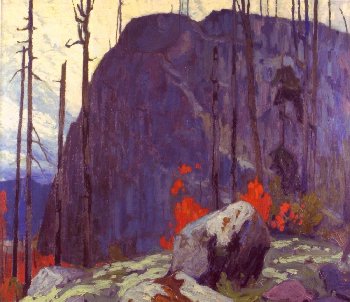
Lawren Harris painting "Algoma Hill" sells for $1.38 million November 21th 2005. TORONTO - A Lawren Harris painting once locked away in the dark of a hospital "broom closet" came back into the light of public admiration Monday, selling at a packed downtown auction house for $1.38 million. The canvas, Algoma Hill, was bought by an anonymous collector through an agent attending the Sotheby's sale of Canadian art, held in association with Ritchies. Spirited bidding for the painting reached $1.2 million, but with the buyer's premium charged by the auction house the total cost topped $1.38 million. The price is not a record for a Harris -- that benchmark was set in May 2001, when Canadian art connoisseur Ken Thomson paid $2.43 million for the 1930 work Baffin Island -- but it did match the upper estimate for the 117-by 137-centimetre oil on canvas and board. "The hammer price on the Harris was $1.2 (million), which is great," said auctioneer Hugh Hildesley, who travelled from Sotheby's New York office to conduct the first half of the 221-lot sale. "It's a wonderful painting," he said of Algoma Hill, completed in 1920, the year that Harris, then 35, founded the Group of Seven. The painting, a landscape from an area north of Sault Ste. Marie, Ont., sets the delicacy of skeletal trees amid flaming red bushes and moss-covered stone against the stark background of a castle-like hill of rock executed in smoky shades of blues, purples and mauves. While his later works, marked by a more abstract style and beloved by poster and print shops, command the highest prices, "for this type of Harris it's a very strong price," said Hildesley. "And it was really good to see it do well, because it deserved to." Yet the ownership of Algoma Hill, rendered with the bold brush strokes and strikingly contrasted palette so prized by Harris aficionados, had been mired in controversy. Almost 80 years ago, the canvas was donated to Toronto Western Hospital (now part of the University Health Network) by Toronto financier Edward Rogers Wood and his wife, Agnes Euphemia Smart Wood. For some years, the painting had hung on a hospital wall, but at some point it was put into storage for safekeeping - described as a "broom closet" by one art expert invited in a decade ago to appraise the work. But when the University Health Network decided to sell the Harris in 2001, the Wood descendants insisted that the painting was a loan, not a gift. The debate continued until a deal was brokered earlier this year, with the hospital network and the Wood heirs agreeing to split the proceeds from Monday's auction. Another Harris painting, Colin Range, Rocky Mountains, sold for $77,250, while his work Row of Six Houses brought down the gavel at $485,500 (all figures include buyer's premium to the auction house). With almost $8.4 million in total sales, Monday's auction set a record for Canadian art sold by Sotheby's Canada, said president David Silcox. Deep-pocketed bidders among the well-heeled crowd of about 250 to 300 people who jammed Ritchies' downtown action site also set records for the works of 10 Canadian artists, including $117,000 paid for a David Milne watercolour, Entrance to the Zoo, and $163,500 shelled out for Group of Seven member J.E.H. MacDonald's Spruce and Maple, Algoma. Another highlight of the sale, Abstract Composition by Jean-Paul Riopelle, sent the bidding up to $485,500. A group of 19th-century Cornelius Krieghoff paintings on offer included his masterpiece Portrait of John Budden, which sold for $405,000, well above the estimate of $200,000 to $300,000. "Overall, prices were extremely strong, with many of the paintings going way above their high estimates," said Hildesley. "What is really encouraging is that the prices were strong across the board, which means that the market is gaining greater breadth, which is something you always look for."
| ||
